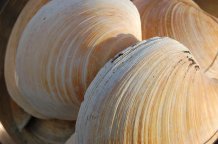Articles

The quahog clam is the longest-living animal on Earth.
Longest-living animal gives climate change clues
A study of the longest-living animal on Earth, the quahog clam, has demonstrated the vital role oceans play in the planet’s changing climate.
By studying the growth rings in the clam’s shells, experts from a group of universities have pieced together the history of the North Atlantic Ocean over the past 1,000 years.
They found that prior to the industrial period (pre 1800), changes caused by variations in the Sun’s activity and volcanic eruptions were controlling our climate by driving changes within the ocean. These ocean changes were then influencing the conditions our ancestors would have felt over the land.
But from 1800-2000 the situation switched, with changes in the ocean (as measured by the record in the clam shells) occurring after changes experienced over land – which the researchers believe are due to the influence of human activity.
“The climate has always changed but it’s happening in a different way than it did in the past, and these dramatic changes are consistent with rising levels of carbon dioxide in the atmosphere,” said co-author Dr Paul Halloran, of the University of Exeter.
“Until now we hadn’t fully understood how important the oceans are in this process.
“The oceans are relatively slow-moving, but they hold and move heat and over time they have the potential to amplify changes, causing major impact on the climate.”
The researchers collected quahog clams – which can live for more than 500 years – from the seabed to the north of Iceland.
The chemistry in the shells’ growth rings – which occur much like the annual rings in the centre of trees – can act as a proxy for the chemical make-up of the oceans, enabling researchers to see how the oceans have changed year-by-year over the past 1,000 years with unprecedented dating precision.
Exeter scientists then used state-of-the-art climate models to link the changes in the shells with changes occurring in the ocean and atmosphere across the whole Atlantic.
Co-author Professor James Scourse has pioneered the use of quahog clam shells to reconstruct past climate changes, a technique that he hopes to develop in new and exciting directions when he moves from Bangor University to the University of Exeter in February.
He said: “This is the first time that an annually-resolved record of marine climate for the last 1,000 years has been generated from anywhere in the global ocean.
“Our findings indicate that human-driven climate change has not only led to overall warming of the surface air temperatures, but it has also led to a reversal in the long-term natural coupling of the marine and atmospheric climate systems.”
The ocean quahog, also known as the Icelandic clam or chowder clam, is an edible mollusc native to the continental shelf seas of North America and Europe.
The clams in the study were collected from the seabed to the north of Iceland, and the findings are published in the journal Nature Communications.
The study Annually resolved North Atlantic marine climate over the last millennium was funded by NERC and undertaken in collaboration with researchers from Bangor University, Cardiff University, University of Exeter, Iowa State University, Aarhus University (Denmark) and the University of Iceland.
Date: 6 December 2016
